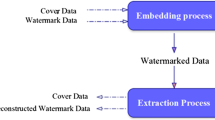Abstract
Based on digital watermark, a speech forensics scheme is proposed. The feature coefficients cross-correlation degree of speech signal is defined, and the property is discussed, which demonstrates that the feature is very robust. Then a new watermark embedding method based on the feature is explored, aiming to enlarge the embedding capacity and solve the security issue of watermark schemes based on public features. In this paper, for each fame of speech signal, it is cut into two parts, and each part is divided into some segments. Then frame number is mapped to a sequence of integers, which are embedded into the segments. The integers can be extracted used for forensics and tamper location after watermarked signal being attacked. Theoretical analysis and experimental results show that the scheme proposed is inaudible and robust against desynchronization attacks, enhances the security of watermark system and has a good ability for speech forensics.




















Similar content being viewed by others
References
Ali AH (2014) An imperceptible and robust audio watermarking algorithm. EURASIP J Audio Speech Music Process 37(1):1–12
Chen OTC, Chia HL, Chia Y (2007) Content-dependent watermarking scheme in compressed speech with identifying manner and location of attacks. IEEE Trans Audio Speech Lang Process 15(5):1605–1616
Chen N, Zhu MY, Liu S (2010) A new fragile audio watermarking scheme. International Conference on Audio Language and Image Processing, pp 367–372
Djendi M, Scalart P (2014) Reducing over-and under-estimation of the a priori SNR in speech enhancement techniques. Digit Signal Process 32:124–136
Herbig T, Gerl F, Minker W (2012) Self-learning speaker identification for enhanced speech recognition. Comput Speech Lang 26(3):210–227
Khan LA, Baig MS, Youssef AM (2010) Speaker recognition from encrypted VoIP communications. Digit Investig 7(1–2):65–73
Lei BY, Song IY, Li Z (2011) Blind and robust audio watermarking scheme based on SVD-DCT. Signal Process 91(8):1973–1984
Li J, Li XL, Yang B, Sun XM (2015) Segmentation-based image copy-move forgery detection scheme. IEEE Trans Inf Forensic Secur 10(3):507–518
Liu ZH, Wang HX (2014) Pseudo-Zernike moments-based audio content authentication algorithm robust against feature-analysed substitution attack. Multimed Tools Appl 70(3):2271–2291
Liu ZH, Wang HX (2014) A novel speech content authentication algorithm based on Bessel-Fourier moments. Digit Signal Process 24:197–208
Ming J, Crookes D (2014) An iterative longest matching segment approach to speech enhancement with additive noise and channel distortion. Comput Speech Lang 28(6):1269–1286
Sahidullah M, Saha G (2012) Design, analysis and experimental evaluation of block based transformation in MFCC computation for speaker recognition. Speech Comm 54(4):543–565
Schwerin B, Paliwal K (2014) Using STFT real and imaginary parts of modulation signals for MMSE-based speech enhancement. Speech Comm 58:49–68
Tabibian S, Akbari A, Nasersharif B (2015) Speech enhancement using a wavelet thresholding method based on symmetric Kullback–Leibler divergence. Signal Process 106:184–197
Vivekananda BK, Indranil S, Abhijit D (2011) A new audio watermarking scheme based on singular value decomposition and quantization. Circ Syst Signal Process 30(5):915–927
Wang HX, Fan MQ (2010) Centroid-based semi-fragile audio watermarking in hybrid domain. Sci China Ser F Inf Sci 53(3):619–633
Wang XY, Ma TX, Niu PP (2011) A pseudo-Zernike moments based audio watermarking scheme robust against desynchronization attacks. Comput Electr Eng 37(4):425–443
Wang XY, Shi QL, Wang SM, Yang HY (2016) A blind robust digital watermarking using invariant exponent moments. AEU Int J Electron Commun 70(4):416–426
Wang Y, Wu SQ, Huang JW (2010) Audio watermarking scheme robust against desynchronization based on the dyadic wavelet transform. Int J Adv Signal Process 13:1–17
Xia ZH, Wang XH, Sun XM, Liu QS, Xiong NX (2014) Steganalysis of LSB matching using differences between nonadjacent pixels. Multimed Tools Appl. doi:10.1007/s11042-014-2381-8
Xiang SJ, Huang JW, Yang R (2006) Robust audio watermarking based on low-order Zernike moments. The 5th International Workshop of Digital Watermarking, pp 226–240
Acknowledgments
This paper is supported by the National Natural Science Foundation of China (Grant No. 61332012, 61272465, 61502409), Shenzhen R&D Program (GJHZ20140418191518323), Nanhu Scholars Program for Young Scholars of XYNU. We would like to thank the anonymous reviewers for their constructive suggestions.
Author information
Authors and Affiliations
Corresponding author
Rights and permissions
About this article
Cite this article
Liu, Z., Huang, J., Sun, X. et al. A security watermark scheme used for digital speech forensics. Multimed Tools Appl 76, 9297–9317 (2017). https://doi.org/10.1007/s11042-016-3533-9
Received:
Revised:
Accepted:
Published:
Issue Date:
DOI: https://doi.org/10.1007/s11042-016-3533-9




